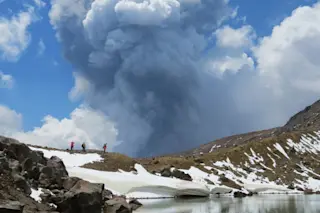The plume from the November 20, 2012 eruption of Tongariro in New Zealand, as seen from Emerald Lakes. Image: Brad Scott, courtesy of GeoNet NZ. Sure, enough, I go away for the week with only my iPhone and something interesting happens. I had mentioned on Monday before I left that volcanologists in New Zealand were concerned about signs of an eruption from Ruapehu but then Tuesday (November 20), almost out of the blue, Tongariro had its second significant explosive eruption of the year. This eruption was from the same Te Maari craters that was the source of the August activity, but this eruption occurred during daylight hours, so the ~3-4 km / 9,800-13,200 foot plume was clearly seen -- especially by hikers caught unawares along the Tongariro Crossings trail (see above). You can see the whole eruption develop on this time lapse of images taken from GNS Science's webcam pointed ...
New Zealand's Tongariro has its Second Eruption of 2012
The Tongariro eruption on November 20, 2012, surprised many with its explosive activity visible to hikers. Discover its impact!
More on Discover
Stay Curious
SubscribeTo The Magazine
Save up to 40% off the cover price when you subscribe to Discover magazine.
Subscribe













